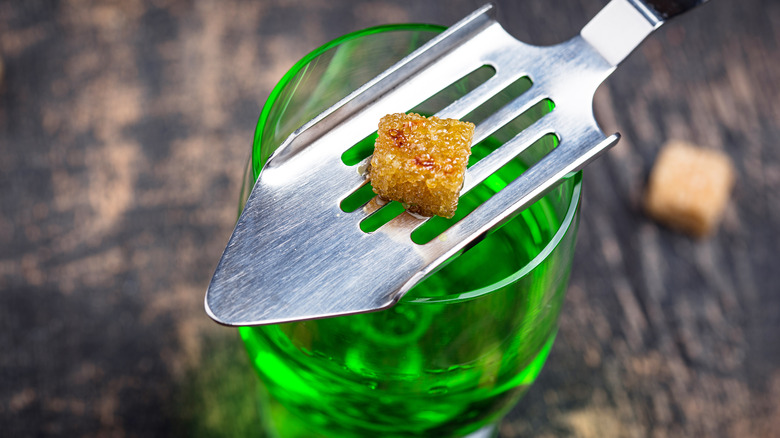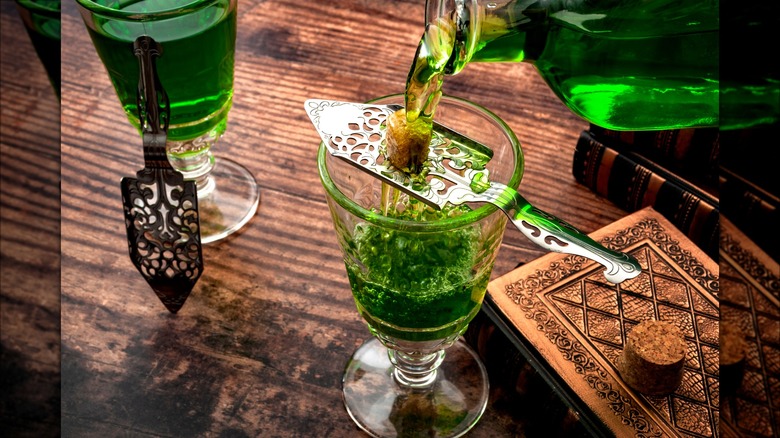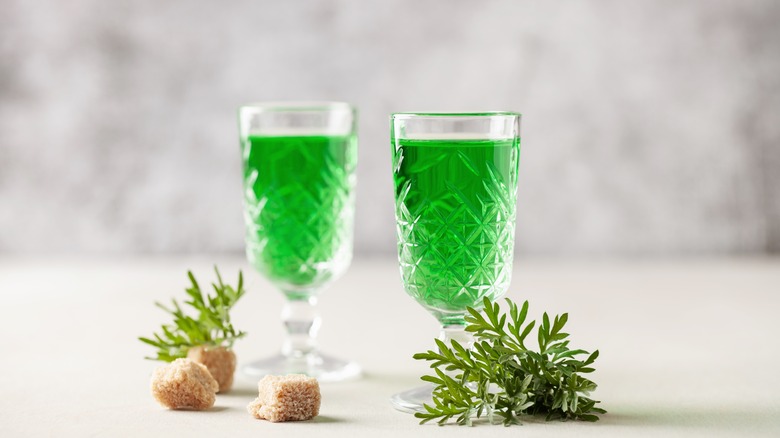The Longstanding Myth About Absinthe You Shouldn't Believe
Have you caught a glimpse of the green fairy? She dances around, revealing magic and a touch of madness as she goes. She's inspired paintings, poetry, and a moral panic that has tainted her reputation for over a century. Her name is absinthe, and she's often misunderstood.
There's no doubt that the verdant, bittersweet spirit, flavored with herbs including anise and wormwood, is high in alcohol. However, absinthe has acquired a reputation that exceeds that of even the booziest beverages. It's often put into a class of its own, outside the reaches of similarly high-proof alcohols such as Everclear or moonshine. Some even viewed the drink as more akin to hallucinogens like LSD: Absinthe drinkers have long maintained its ability to alter the mind or send one into a stupor – just think of the lonesome woman in Edgar Degas' "In a Cafe." But can absinthe actually cause its imbibers to hallucinate? The short answer is no. The longer answer is no, and it never has.
As it turns out, that green fairy is more fantasy than reality, and absinthe's so-called otherworldly powers come down to high alcoholic content and some keen artistic influence. There are aspects of the drink, such as its unique infusion of herbs, that are often used to justify its reputation as a psychedelic. However, these ingredients mostly contribute to the drink's green color and distinctly herbaceous taste; they won't produce or inspire any otherworldly visions, contrary to popular belief.
The myth of the green fairy
The history of absinthe comes in two parts: pre- and post-ban. The liquor was invented in the late 18th century and became increasingly popular in the 19th century, serving as a staple drink for many artists living in Paris during the Belle Epoque period. The period spanned from 1871 through 1914 and was characterized by broad economic expansion, industrialization, and an art movement that brought Paris to life.
However, this time was also pocked by economic inequality, the rapid spread of diseases such as tuberculosis and syphilis, and an overall increase in alcohol consumption and drug use. Absinthe was one of the more popular drinks during this time period, as it was both inexpensive and potent. The drink was a favorite of both the working class and artists (who often portrayed it in their works and used it for inspiration). In that way, absinthe served as the ultimate muse for a period marked by societal change and artistic renaissance.
That is, until the break of the 20th century, when the temperance movement marked absinthe — a drink popular among the working class and bohemians — as public enemy number one. Many of those in the anti-absinthe movement were quite vocal about the evils of the green drink, which they claimed could cause hallucinations and violent rage. Their claims were seemingly further bolstered by the absinthe murders of 1905, in which two Swiss men murdered family members days apart after binge drinking that included absinthe.
Post-ban absinthe
After the highly publicized murders, absinthe was widely banned across Europe and in the United States, serving as a precursor to a wider movement that sought to end the consumption of alcohol. And though, across the sweep of history, the temperance movement and ensuing alcohol prohibition failed (despite spawning several classic retro cocktails like the 7 and 7), its impact on the reputation of absinthe has proven strangely potent. Thanks to the highly publicized absinthe murders, as well as the popularity of artworks that portrayed the drink as an almost magical substance, its notoriety stuck around, much like its ban, for almost a century.
In fact, many countries, such as the United States, banned the drink until the beginning of the 21st century. And even after it was re-legalized, absinthe kept its reputation as a substance whose capabilities exceeded the typical spirit. However, the world of alcohol is not the same as it was in 1905, and the production of absinthe is much more controlled than it was at the turn of the 20th century. The drink's contents, including wormwood, are highly controlled. So absinthe is, in its current form, no more dangerous than other high-proof alcohols, such as Everclear.
An alcohol like (and unlike) any other
But what, exactly, was the supposed psychoactive ingredient in absinthe? Wormwood was the main culprit, at least for scientists hoping to prove the drink's harmful properties. According to author Doris Lanier's book "Absinthe: The Cocaine of the 19th Century" " temperance-minded researchers at the turn of the 20th century injected extract from the shrub into small animals and found that the plant caused these animals to convulse. Wormwood indeed contains thujone, a chemical compound that can, in large amounts, cause seizures.This compound, and wormwood in general, were believed to be the cause of absinthism, the syndrome used to cover the many unpleasant side effects associated with absinthe consumption.
However, it's now known that neither wormwood nor thujone are found in absinthe at levels that would lead to what is described as absinthism. This isn't exclusive to post-ban absinthe, either. Pre-ban absinthe was also low in thujone. So, components such as wormwood really only add to the drink's flavor, which is also why absinthe makes for an invigorating twist on the standard martini.
So what about this mythical drink links it to such extreme shifts in behavior? The answer is simple: alcohol. Absinthe's generally high alcohol content makes its effects much more noticeable than beer or whiskey (or whiskey's alcoholic relative, bourbon). However, none of absinthe's ill effects are any different from the overconsumption of any other highly alcoholic drink. So perhaps moderation is key.



